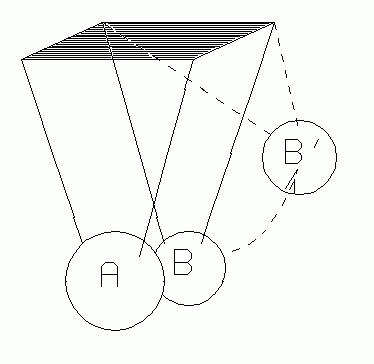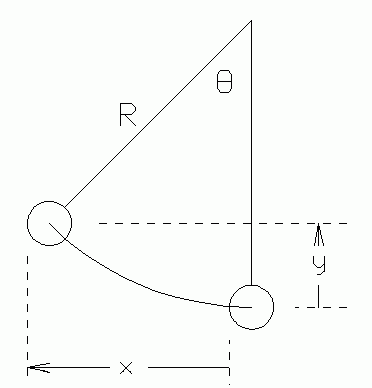D-4 CONSERVATION OF ENERGY AND MOMENTUM
To demonstrate that momentum is conserved in any impact, and kinetic energy is conserved in elastic impacts.
2. APPARATUS:
Two steel balls of different sizes, suspension frame, string, position indicators, metric balance, and meter stick.
3. PROCEDURE:
 |
| Fig. 1. The bifilar suspension. |
|---|
The collision of two steel balls will be investigated. The balls are supported by a bifilar suspension to provide lateral stability, as shown in fig. 1. The lengths of the supporting strings may be accurately adjusted by screws on the top support. This adjustment is very sensitive, even the slightest maladjustment will cause the balls to wobble laterally after they collide.
The small ball is pulled back 5 to 10 cm, then released and allowed to collide with the larger ball. Both balls will rebound from the collision. The velocities just before and just after impact may be determined by measuring the initial and rebound positions of both balls, for in such a pendulum arrangement the potential energy at the highest point of the swing equals the kinetic energy at the lowest point. There is negligible heat loss during the free swing.
To calculate the potential energy of a ball at the highest point of its swing it is necessary to know the vertical height of rise from the lowest point. If the radius of the suspension (measured in a vertical plane) is known, the height may be determined in either of two ways. (1) Measure the angle of swing, q, then use trig relations to calculate y (see figure 2 below). Or alternately, (2) measure the horizontal distance of swing, x, then relate this to h by the Pythagorean theorem. In either case, show a derivation of the relation you use to calculate y.
(1) ELASTIC COLLISION. Make a number of determinations of initial and final positions of both balls. Record this data in an organized way on your data sheet. Calculate the kinetic energy of each ball just before and just after impact. Also calculate the momenta, being sure to include the algebraic signs.
Find the total energy before impact and compare with the total energy after impact. Do the same for the momentum. Was the collision perfectly elastic? You must do an error analysis to answer this question, for you must know how much lack of agreement in your energies might be due to experimental uncertainties.
 |
| Fig. 2. Geometry of the swing. |
|---|
(2) INELASTIC COLLISION. Place a small amount of putty or modeling clay at the point of impact on the larger ball. You may be able to make this so inelastic that the two balls do not separate after impact, but continue to move together. Check conservation of energy and momentum as before. How much thermal energy was produced in the impact?
4. QUESTIONS:
(1) How much error is introduced in the results by ignoring the rotation of the balls as they swing? We refer here to the rotation caused by the suspension system. As the ball swings through angle q it also rotates through angle q, about a horizontal axis perpendicular to the plane of swing. Look at fig. 2 and visualize the swing. Rotational kinetic energy is involved here. A quantita- tive answer is desired. What percent determinate error would result in this experiment from neglect of this part of the kinetic energy?
5. RELATED READING:
Newton's cradle is a toy consisting of five or more steel balls arranged in a bifilar suspension so that they may collide. It is sometimes called "Newton's balls, colliding balls, executive pacifier, and "the counting balls". Investigate it and ask to see the apparatus. This document raises many questions that relate to this experiment, some of which you may investigate.
Text and figures © 1997, 2004 by Donald E. Simanek.